SpaceX’s Starship SN10 EXPLODES on the launch pad just minutes after making a soft landing
Elon Musk’s SpaceX’s Starship SN10 explodes ten minutes AFTER making first successful return to the launch pad
- SpaceX’s Starship Serial Number 10 (SN10) launched Wednesday for its first high altitude flight
- The rocket climbed six miles, hitting its altitude mark and then prepared to return to the launch pad
- Viewers tuning in were focused on if it will or will not land, as its predecessors crashed and exploded
- However, minutes after the perfect landing SN10 exploded while standing tall on the launch pad
SpaceX’s Starship Serial Number 10 (SN10) exploded roughly 10 minutes after landing on the launch pad following its first high altitude test flight that sent the massive rocket soaring six miles into the air, with some suspecting a methane leak is to blame.
The failure occurred after SpaceX declared it a success, as SN10 flew, flipped and landed without crashing and burning like the previous prototypes SN8 and SN9 – CEO Elon Musk praised the rocket in a tweet for ‘landing in one piece.’
‘Third time’s a charm, as the saying goes,’ SpaceX principal integration engineer John Insprucker said during SpaceX’s livestream Wednesday.
‘We’ve had a successful soft touchdown on the landing pad that’s capping a beautiful test flight of Starship 10.’
The cause of the explosion has not yet been revealed, but Musk has referred to such events as ‘RUD,’ or Rapid Unplanned Disassembly.
Some sources speculate the landing legs attached to the base did not deploy, which sent the rocket toppling over, and crushed pipes holding methane.
An object that could be a methane tank was seen lying on the Boca Chica landing area.
SN10 took off from SpaceX’s Boca Chica, Texas testing facility at 6:15pm ET, following the same path as both the SN8 and SN9 prototypes that exploded when attempting to land.
The rocket soared through the sky, propelled by its three powerful Raptor engines that turned off one by one until a single engine was left.
SN10 reached the six-mile mark four minutes into its flight and hovered above the earth using a single engine before turning on its side for the ‘belly flop.’
As SN10 headed back to the launch pad, it re-orientated itself to land vertically and touched down as smoke came blowing out from the base – but it suffered the same fate as its predecessors shortly after.
However, the prototype’s mission was to gather data on controlling the rocket during re-entry and many are calling the launch a success rather than another Starship failure.
Scroll down for videos


SpaceX’s Starship Serial Number 10 (SN10) exploded roughly 10 minutes after landing on the launch pad following its first high altitude test flight that sent the massive rocket soaring six miles into the air.
SN10 was patiently waiting on the launch pad for its chance to follow in the steps of the SN8 and SN9 prototypes.
The rocket was set to take off at 3:20pm ET, but moments after the rocket ignited its Raptor engines the onboard computers activated an abort due to a detected issue.
Musk tweeted shortly after the halt saying: ‘Launch abort on slightly conservative high thrust limit. Increasing thrust limit & recycling propellant for another flight attempt today.’
The SpaceX team worked quickly detanking and refueling the 165-foot stainless steel vehicle with the hopes that it would take flight later that day – and their wishes were granted.


The cause of the explosion has not yet been revealed, but Musk has referred to such events as ‘RUDs,’ or Rapid Unplanned Disassembly. Some sources speculate the landing legs attached to the base did not deploy and sent the rocket toppling over, while others say there was a methane leak


SpaceX CEO Elon Musk shared a tweet moments after SN10 exploded celebrating that the rocket landed in one piece
Although SpaceX seems to be focused on reaching the maximum altitude with Starships, the entire agenda of these flights is to gather data and test key mechanics on the rockets.
Igniting all three Raptor engines for liftoff and then shutting them off one by one are all intentional actions, which also saves energy for when they need to power back on to lower the massive rocket to the launch pad.
The decent was controlled under active aerodynamic control, accomplished by independent movement of two forward and two aft flaps on the vehicle, all of which SpaceX was set on testing during this mission.
Insprucker said following the successfully landing that the next prototype, SN11, is ‘ready to roll out to the pad in the very near future.’
SN10 is nothing more than a pile of rubble, but the firm may have been able to capture all the data it needed and could announced the mission as a success – just as Musk did when the first prototype exploded.
SN8 took to the skies on December 10 – marking the first high altitude attempt of a Starship prototype.
The rocket hit all the marks including shutting down its Raptor engines, reaching an altitude of 7.8 miles and performing the belly flop.
The only thing it was unable to perfect was the landing, but Musk said previously that the rocket was unlikely to land safely.
The moment the rocket touched down, it ignited in flames and left nothing behind but its nose cone.
Then came the next prototype, SN9, which SpaceX had high hopes of landing when it attempted its high altitude test flight in February.


However, the prototype’s mission was to gather data on controlling the rocket during re-entry and many are calling the launch a success rather than another Starship failure


SN10 took off from SpaceX’s Boca Chica, Texas testing facility at 6:15pm ET, following the same path as both the SN8 and SN9 prototypes that exploded when attempting to land


SN10 reached the six-mile mark four minutes into its flight and hovered above the earth using a single engine before turning on its side for the ‘belly flop


As SN10 headed back to the launch pad, it re-orientated itself to land vertically and touched down as smoke came blowing out from the base – but it suffered the same fate as its predecessors shortly after
This time the rocket was unable to maneuver into the vertical position before landing on the launch pad, hindering its ability to stick the landing.
It landed with a deafening crash, and exploded into bright orange flames and a dust cloud, but the fire did not spread.
Starship is about the size of a 15-story building that is constructed of stainless steal, which keeps the mechanics cool while the rocket fills with heat and soar through the sky.
The development of Starship has been rapid, with new prototypes and next generation models developed concurrently to allow for quick changes.


SpaceX ‘s Starship Serial Number 10 (SN10) aborted its first high altitude test flight moments after igniting its powerful Raptor engines


SN8 took to the skies on December 10 – marking the first high altitude attempt of a Starship prototype. The moment the rocket touched down, it ignited in flames and left nothing behind but its nose cone


SN9 was unable to maneuver into the vertical position before landing on the launch pad, hindering its ability to stick the landing
In the past year alone SpaceX has completed two low-altitude flight tests with SN5 and SN6 and over 16,000 seconds of run time during ground engine starts.
Musk recently an ambitious plan to get humans on Mars by 2026 – seven years before NASA aims to land astronauts on the Red Planet.
And Starship rockets are key players in turning that dream into a reality.
Apart from Mars, the rocket, if it becomes operational, could also prove useful for closer trips, especially to the Moon
Also on Wednesday, Japanese billionaire and online fashion tycoon Yusaku Maezawa, who paid an undisclosed sum for a SpaceX lunar spaceship trip expected to launch in 2023 at the earliest, threw open the application process for eight people from around the world to join him.
He announced the move in a video posted on Twitter in which Musk tells potential applicants: ‘I’m highly confident that we will have reached orbit many times with Starship before 2023 and that it will be safe enough for human transport by 2023. It’s looking very promising.’
The mission will be the first private space flight beyond Earth’s orbit, Musk said.
![]()



